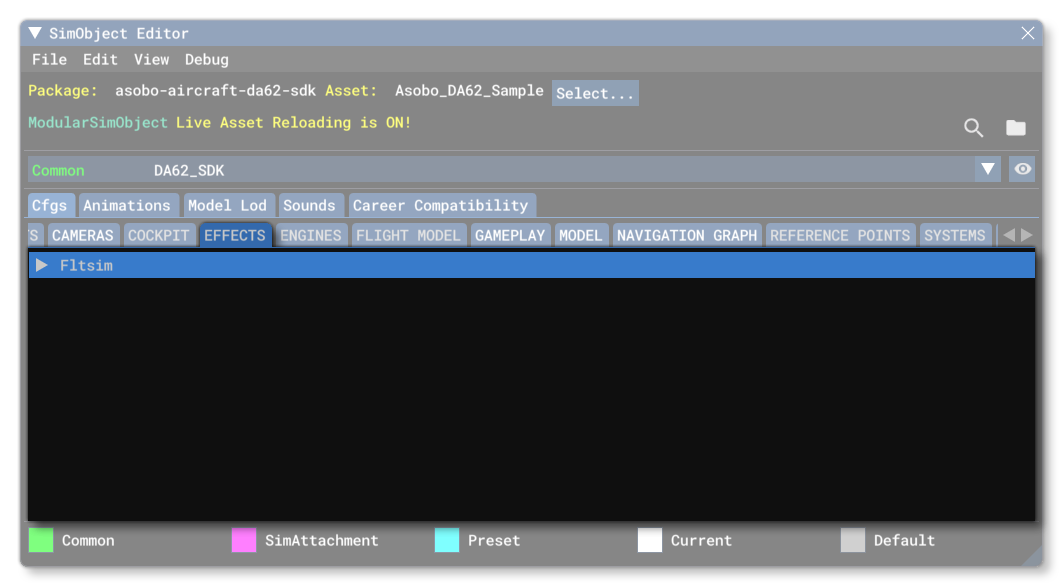effects.cfg

The effects.cfg file is an optional file which can be included in the effects folder of a modular SimObject. This file is used to specify one or more fallback directories for lighting effects in case the effects folder of your SimObject or attachment does not have the referenced light effect, for example:
- when sharing effects between similar SimObjects
- when reusing an effect from a parent for a variation
These are two common use cases in which having fallback directories avoids copy-pasting lighting effects necessarily.
For more information on creating lighting effects, please see here:
[Version]
The [Version] section provides version information for the configuration file. In Microsoft Flight Simulator 2024, major versions should always be at least equal to 1.
Note that this information is mandatory and should always be included.
| Parameter | Description | Type | Required |
|---|---|---|---|
| major | Major CFG file version number, values must be greater than 0. | Integer | No |
| minor | Minor CFG file version number, values must be greater than 0. | Integer | No |
[fltsim]
The [fltsim] section has the following parameter and is used to define one or more fallback folder for light effects.
Using The effects.cfg File
To specify fallback directories using the effects.cfg file, you would need to create the file inside inside your SimObject effects folder.
NOTE: The folder may be named something other than "effects" if required, as long as the new folder name is specified in the effects parameter of the aircraft.cfg.
In the effects.cfg file you would write the different folders to fallback to, using the [fltsim] header. Inside this section, fallbacks are defined via the fallback.[index]=<path> syntax, where the index must start at 1 and must be incremented by 1 for each fallback directory, for example:

In this example, given the effect name "LIGHT_NavigationRed", the game will attempt to load the effects at these locations, stopping at the first valid path for which the effect exists:
SimObjects/Airplanes/Asobo_T6_Reno/Common/effects/LIGHT_NavigationRed.fxSimObjects/Airplanes/Asobo/effects/LIGHT_NavigationRed.fxSimObjects/Airplanes/MyAircraft/common/effects/LIGHT_NavigationRed.fxSimObjects/Airplanes/Aobo_L39_Reno/common/effects/LIGHT_NavigationRed.fxeffects/LIGHT_NavigationRed.fx
The last path (effects/LIGHT_NavigationRed.fx) is implicitly added to fallback to the global effects folder in case the effect could not be found.
IMPORTANT! If you define an effects.cfg file, the PackageTool will check that your folders exist, and having a fallback folder which does not exist will result in an error. The missing fallback folder will be specified in the error.
So, to sum up:
- When loading an effect, the game will look inside your SimObject common/attachment/preset folder for the effects folder (or the appropriate folder name if you are working on a variation).
- If the specified effect cannot be found, the game starts using fallback directories specified inside
effects.cfg. - The global effects folder is implicitly used as a fallback directory if none of the provided fallback folders contained the effect.
- The global effects folder is considered even if the
effects.cfgis non-existent, to make sure older packages can still access their effects.
This behaviour provides a way to override a base effect from the global effects folder - or the base package if applicable - for your SimObject by giving it the same name as the base effect.